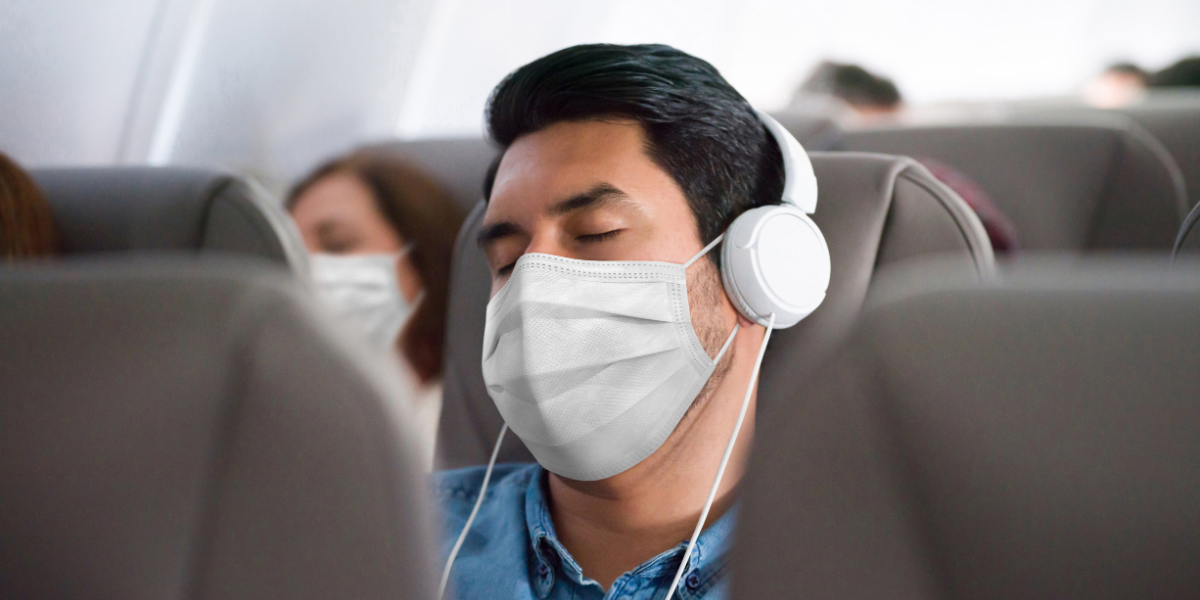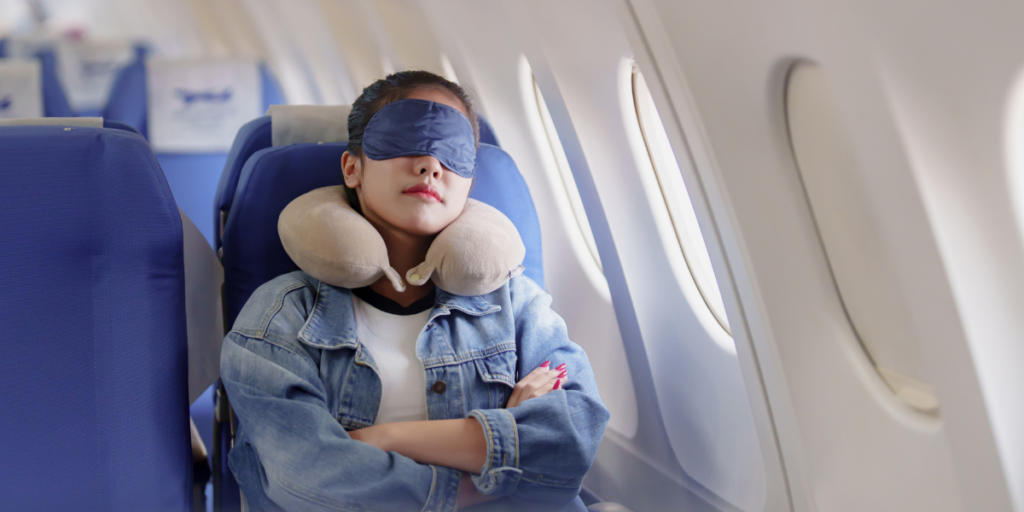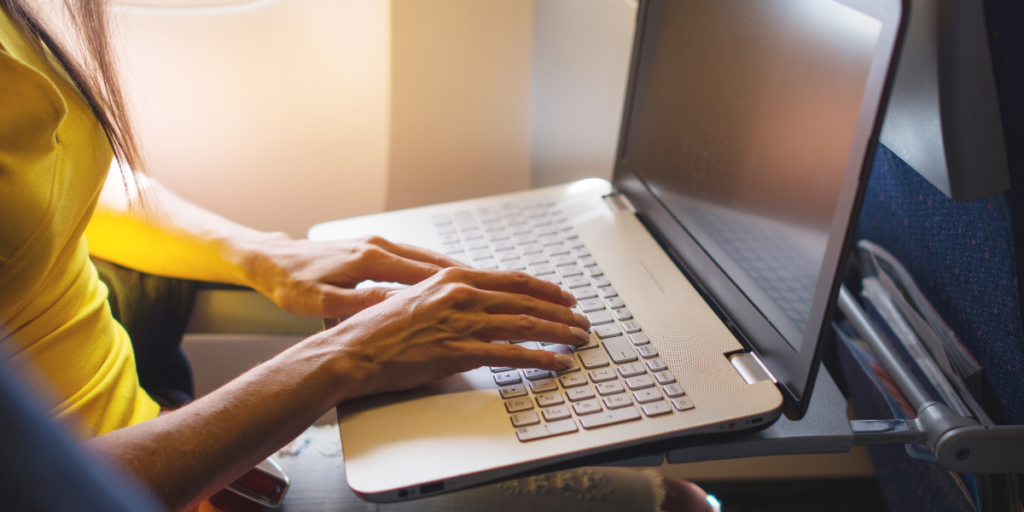Key Takeaways:
- Understanding In-Flight Challenges: Learn why sleeping on a plane can be tough and what makes it difficult for most travelers.
- Practical Sleep Tips: Discover essential techniques and accessories that enhance comfort, from seat choices to calming practices.
- Pre-Flight Preparation: Explore ways to prepare before boarding, setting you up for a smoother in-flight rest experience.
Struggling to sleep on a plane? For many, the discomfort, bright lights, and constant activity make restful sleep seem impossible. Imagine having a tool to transform this experience, delivering warmth and comfort to ease your eyes and calm your mind, helping you unwind even in the busiest cabin. At Reposé, we understand the art of relaxation, offering our self-heating eye masks designed to soothe, reduce puffiness, and elevate your travel comfort.
In this guide, we share proven tips for a better in-flight rest, ensuring your journey starts refreshed.
Why Sleeping On A Plane Can Be Challenging
For many travelers, achieving quality sleep on a plane feels nearly impossible. Several factors contribute to this difficulty, including cramped seating, limited legroom, and frequent interruptions from fellow passengers and cabin crew. Cabin conditions also play a significant role: the low humidity levels and higher altitudes can lead to dehydration, making sleep less restorative and more uncomfortable. Additionally, the changes in cabin pressure can cause mild discomfort, making it harder to relax fully. Noise from engines and cabin activity can disturb even the lightest sleeper, while unfamiliar surroundings may add to feelings of restlessness. Understanding these challenges is the first step toward a more comfortable in-flight rest experience.
Ready for the ultimate in-flight relaxation? Discover the Repose Heated Eye Mask and experience soothing warmth that helps you unwind, reduce eye strain, and drift off into restful sleep – no matter where you are. Perfect for travelers seeking comfort on the go. Shop Now and elevate your travel relaxation today!
Essential Tips For A Comfortable In-Flight Sleep
To maximize comfort and increase your chances of restful sleep on a plane, consider these essential tips:
- Choose Your Seat Wisely: If possible, opt for a window seat to have a wall to lean against and avoid disruptions from fellow passengers. The front of the plane is generally quieter and experiences less turbulence than the back.
- Wear Comfortable Clothing: Loose-fitting, breathable layers allow you to adapt to the plane’s varying temperatures. Compression socks can also help prevent swelling and promote circulation.
- Bring Sleep Accessories: A quality neck pillow, eye mask, and noise-canceling headphones or earplugs can make a significant difference. These items create a cocoon-like environment, helping block out light and noise.
- Stay Hydrated but Avoid Excess Liquids: Hydrate before boarding and take small sips during the flight. Avoid caffeine and alcohol, which can disrupt sleep and lead to dehydration.
- Practice Relaxation Techniques: Deep breathing exercises or listening to calming music or sleep podcasts can signal your body to wind down, even in a busy environment.
These foundational tips can transform your in-flight sleep experience from restless to restful, setting you up for a more enjoyable journey.
Preparing Before You Board
Ensuring a restful sleep during your flight starts well before you even step on the plane. With the right preparation, you can ease the transition to a new time zone, enhance your comfort, and set yourself up for a smoother in-flight sleep experience. Here’s how to get ready before boarding for a restful journey.
Adjust Your Sleep Schedule Gradually
If you’re crossing time zones, adjusting your sleep and wake times a few days before departure can be highly beneficial. Aim to align your schedule with your destination’s time zone to help your body transition, reducing the impact of jet lag and making it easier to rest on the flight.
Pack A Personalized Sleep Kit
A well-prepared sleep kit can make all the difference for in-flight comfort. Consider bringing items like an eye mask, noise-canceling headphones, a compact travel blanket, and a neck pillow. These essentials can help create a comfortable, sleep-conducive environment, making it easier to relax and rest as soon as you’re settled in.
Eat A Light, Balanced Meal Before Departure
Eating a light, balanced meal before boarding helps support digestion, promoting comfort and relaxation during the flight. Avoid heavy or overly rich foods, as these can disrupt digestion, leading to discomfort and making it harder to fall asleep once on board.
Limit Screen Exposure Before Boarding
Minimizing screen time before the flight can improve your chances of restful sleep. Blue light from screens interferes with melatonin production, the hormone that helps regulate sleep. Reducing screen exposure right before boarding allows your mind and body to prepare for a more restful experience during the flight.
How To Stay Relaxed And Comfortable During The Flight
Achieving relaxation and comfort during a flight is essential for getting quality rest. Small adjustments and mindful practices can make your journey significantly more enjoyable, helping you arrive at your destination feeling refreshed and ready. Here’s how to stay calm and comfortable throughout the flight.
Set Up Your Personal Space Mindfully
Once seated, take a moment to arrange your space so everything essential is easily accessible. Having your items within reach minimizes unnecessary movement, allowing you to settle in without disruptions. Adjust your seat to a comfortable position and fasten your seatbelt for security, balancing comfort with in-flight safety.
Engage In Mindfulness And Breathing Exercises
Breathing exercises, like inhaling for four counts and exhaling for six, can effectively reduce stress and promote relaxation. Practicing mindfulness or using a meditation app can deepen this relaxation, allowing your mind and body to unwind. These practices not only ease tension but also prepare your body for restful in-flight sleep.
Incorporate Gentle Stretching For Circulation
Stretching periodically during your flight helps stimulate circulation and prevents muscle stiffness. Simple movements like ankle rotations, neck tilts, and shoulder rolls can make a notable difference in maintaining comfort. By encouraging blood flow, these stretches reduce the risk of discomfort from prolonged sitting.
Adjust Layers To Regulate Temperature
Cabin temperatures fluctuate, so having layers handy can keep you comfortable as conditions change. Use a travel blanket, scarf, or sweater to stay warm, and remove layers if you start to feel too warm. Being able to control your temperature is a simple yet effective way to ensure a relaxing, uninterrupted journey.
What To Avoid For Better In-Flight Rest
To get quality in-flight rest, it’s just as important to know what to avoid as it is to plan for comfort. Certain actions can undermine your chances of getting the sleep you need, so sidestepping these pitfalls can make all the difference. Here’s what to steer clear of for a restful journey.
Skip Caffeine And Alcohol For Better Sleep Quality
Both caffeine and alcohol can work against your body’s natural sleep cycle, making restful sleep more elusive. Caffeine stimulates the nervous system, keeping you alert and awake, while alcohol may initially cause drowsiness but disrupts deep sleep stages and leads to dehydration. Avoiding these beverages can help you relax and enjoy more restorative rest during the flight.
Avoid Overeating To Prevent Discomfort
Eating large or heavy meals before or during the flight can result in bloating and indigestion, which can hinder your ability to relax. The discomfort from overeating can keep you from settling into a comfortable sleeping position, so lighter, easy-to-digest snacks are a better choice. Opting for a balanced meal can promote relaxation and improve your chances of sleeping well.
Limit In-Flight Entertainment To Reduce Eye Strain
Relying on screens for long stretches can strain your eyes and interfere with melatonin production, a hormone crucial for sleep. Extended screen use can keep your mind stimulated, making it harder to unwind and fall asleep. Consider screen-free activities like reading or listening to calming music to promote a more restful state.
Refrain From Stressful Thoughts Or Work-Related Tasks
Using the flight time to handle stressful tasks or projects can elevate stress levels, making it harder to relax. Instead, view the flight as an opportunity to disconnect, rest, and recharge so you arrive at your destination refreshed. Avoiding stressful thoughts will not only enhance your sleep but also help you maintain a positive, relaxed mindset during the journey.
Final Thoughts
Achieving restful sleep on a plane can be challenging, but with the right preparation and mindset, you can significantly improve your in-flight comfort. By planning ahead, choosing the best seat, and bringing essential accessories, you can create a more restful environment even in a busy cabin. Additionally, practicing relaxation techniques and being mindful of your food and drink choices can help you drift off more easily. While sleeping on a plane may never match the comfort of your bed, following these tips can make your journey more enjoyable and leave you feeling refreshed upon arrival.
Read also:
- Eucalyptus Oil for Skin: The Natural Way to Soothe and Heal
- Ultimate Guide to Serums for Face Hydration and Care
- How to Choose the Right Hydrating Toner for Every Skin Type
Frequently Asked Questions About Sleeping On Planes
Why is sleeping on a plane so difficult?
Sleeping on a plane is challenging due to noise, uncomfortable seating, changes in cabin pressure, and a lack of control over the environment. These factors disrupt rest and make it hard to relax.
Do travel pillows actually help with sleep?
Yes, a quality travel pillow supports the neck and prevents strain, helping you maintain a comfortable position, which can ease the process of falling asleep.
How can I manage jet lag after arriving?
Adjusting to the new time zone before departure, staying hydrated, and getting sunlight exposure upon arrival can help reset your internal clock and minimize jet lag.
Can eye masks really improve in-flight sleep?
Absolutely! Eye masks block out ambient light, which helps stimulate melatonin production, essential for inducing sleep, especially in well-lit airplane cabins.
Is it safe to use sleep aids on a plane?
While mild sleep aids are generally safe, consult a doctor before use. Some sleep aids may have side effects, and their effects can feel more intense in an airplane’s environment.
Are heated eye masks suitable for travel?
Yes, heated eye masks are convenient and ideal for travel. They offer warmth and comfort, relieving eye strain and creating a soothing environment even in the air.
What are the best snacks for sleep on a plane?
Choose light snacks like almonds, bananas, or whole-grain crackers, which contain nutrients that can help the body relax and encourage restful sleep.
Can I use essential oils to sleep better on a flight?
Yes, certain essential oils like lavender and chamomile can promote relaxation. Consider applying a small amount on a travel pillow or using an infused eye mask.
Is it better to sleep or stay awake during short flights?
For flights under three hours, staying awake might be preferable, especially if it’s a daytime flight. Short naps can leave you groggy, while staying awake helps you stay aligned with your routine.
What is the best seat for sleeping on a plane?
Window seats are often the best for uninterrupted sleep, allowing you to lean against the wall and avoid frequent disruptions from other passengers.










